A key part of building a brand using social media is setting targeted goals and developing your social media marketing strategy with a clear direction. Taking the time to identify clear social media goals will help you get the most out of social media marketing campaigns.
In this post, we will outline why goals matter for your social media marketing strategy, how to set SMART social media goals for your brand, which KPIs you should track for each type of goal, and how to track the impact of these social media goals. Keep scrolling to get started!
- Why Is It Important To Set Social Media Goals?
- How Will You Make Sure You Are Setting The Right Goals?
- 5 Social Media Goals To Keep Your Social Media Marketing Strategy On Track
- Conclusion
You can directly jump to a section of your choice or keep scrolling.
Why Is It Important To Set Social Media Goals?
As a business owner, you may be posting to social media randomly without having any clear objectives in mind. Setting social media goals is essential to a precise, streamlined, and focused approach to social for your business. Here's why they are important:
1. To Guide Your Content Strategy
Once you have set your social media goals, you can create your social media content calendar. For each post that you create for social, you should be asking yourself, "what is the primary goal of posting this content?"
When you have clear goals defined, you can plan and create content for social media that would help you achieve those goals. For instance, if your main goal is to increase brand awareness, you should focus more on creating and posting content that gets your name in front of more customers.
2. To Make Smart Decisions About Your Business
Setting goals gets you acquainted with precise and accurate data in order to make smart decisions for your business. The goal should be measurable, which means that you will need to track certain KPIs (key performance indicators) and social media metrics. The data gathered will help you know more about your business and product from your customer's perspective. You can even make informed data-driven decisions to improve your business.
For example, if your main goal is to grow your audience on social media, you will need to track the following KPIs: follower count, brand mentions (who has talked about your brand or business on social media), and engagement on your posts (likes, comments, shares).
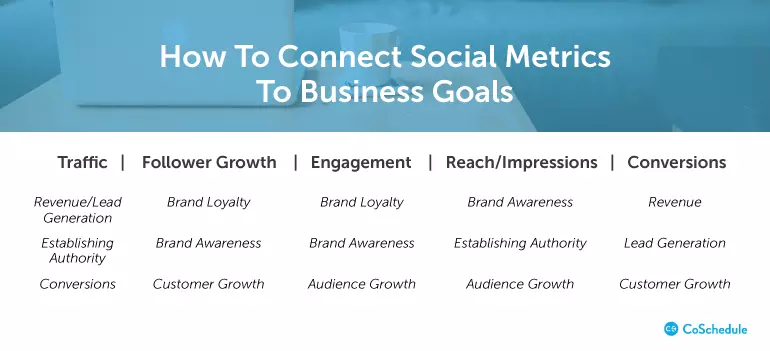
3. To Showcase Results And Impact Of Campaigns Run
Set social media goals and make tangible progress in achieving those goals over time. At the end of your strategy timeline, this allows you to prove the overall effectiveness of your campaign. The data you get from social media can help inform other areas of your business such as P.R., products, and even finance.
4. To Dictate Future Marketing Strategies
Having results of the progress made and measurements of effectiveness allows you to know what is and what is not efficient in your marketing strategy. You will be able to see what is resonating with customers versus what they tend to ignore.
Knowing these can keep your goals conforming to the needs and wants of your customers. It allows you to constantly improve upon your social media strategy to achieve the best possible results.
How Will You Make Sure You Are Setting The Right Goals?
Failing to meet your social media goals has nothing to do with who you are. But, it has everything to do with the goals you set for yourself. The key to selecting the right social media goals is following a SMART quality check while defining them.
The easiest way to go about doing this is by starting with a broad business goal. Then you can run those through the SMART goal-setting process. By the end, your social media goal will morph into something valuable you can use for positive growth.
Setting SMART goals will also help you with work efficiency by ensuring peace of mind on the psychological front. Instead of overworking, you can achieve more without much effort.
On a similar note, social media goal-setting will result in more consistent workweeks, which means you will be maintaining a healthy work-life balance.
SMART Goal Setting
SMART stands for specific, measurable, attainable, relevant, and timely.
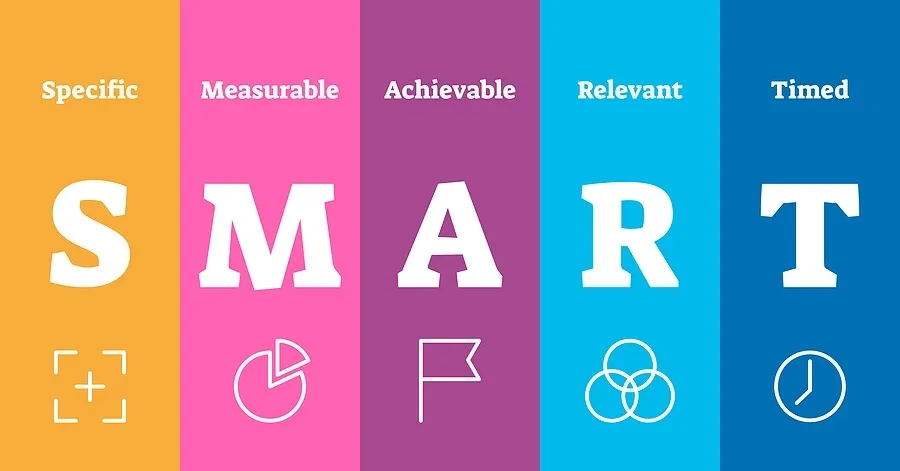
Image Source: ClicData
S=Specific: Be specific about what you want to accomplish and answer the 'what' and the 'where.'
- Not specific enough goal: Increase brand awareness.
- Specific goal: Increase brand awareness on social media within your immediate community.
M=Measurable: Ensure your goals are accurately measurable. Decide the metrics you are going to use. Some common metrics for social media campaigns include engagement (likes, comments, shares), follower count, post reach, and impressions.
- Not measurable goal: Increase my follower count.
- Measurable goal: Increase my follower count by 20%.
A=Attainable: Set an attainable and realistic goal for yourself. Think if you have all the tools and skills required and necessary to accomplish each of your goals.
Attainability is unique to each situation. Ensure you are able to realistically achieve the goal you set!
R=Relevant: Ensure that your goals are in line with your company strategy.
Relevancy depends on each unique situation. Ensure to set goals that will help you grow your brand on social media.
T=Timely: Think about the timeline of your goals and when you are projecting to accomplish them. Remember to be realistic (here as well)!
- Not timely goal: Increase my follower count by 20%.
- Timely goal: Increase my follower count by 20% within 3 months.
So all points summed up, an example of a SMART goal would be:
Increase brand awareness on social media within the immediate community by growing my follower count by 20% and my social media reach to an average of 400 users per post within 3 months.
Next, you would need to take note of where your KPIs (in this case: post reach and follower count) are at now so that in 3 months' time, you will be able to measure your progress and growth.
5 Social Media Goals To Keep Your Social Media Marketing Strategy On Track
There are tons of possibilities for goal setting on social media. Here are five social media goal examples along with their specific KPIs to get you started:
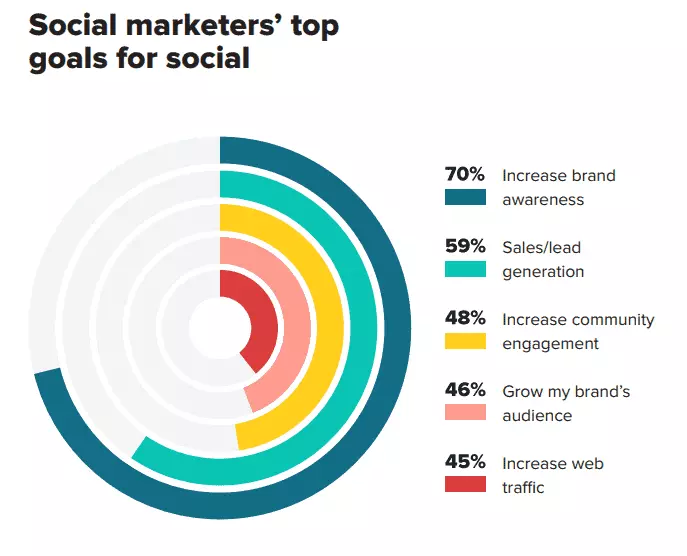
Image Source: Smart Insights
Goal 1: Increase Brand Awareness
With over 4.88 billion people now using social media worldwide, this channel has become one of the best places for brands to promote themselves and make a name for themselves. If you want to build your reputation online and get attention on social media, then brand awareness should be one of your social media goals. Developing content that cuts through the clutter and connects with your audience will be challenging.
To build brand awareness, your content should be of high quality and valuable enough for people not just to read themselves but also share it with others. Providing information or tips that are useful and enjoyable to your audience is the key to building brand awareness on social media.
One of the best ways to measure your brand awareness on social media is to look at your posts' reach, followers, shares, and mentions. Brand awareness ultimately works hand-in-hand with engagement, so you need to create engaging content if you want people to know about your brand.
Brand awareness is a goal that every business looking to grow on social media should set. You need to increase brand awareness in order to gain more potential customers. Sharing content on social media means getting your brand out there.
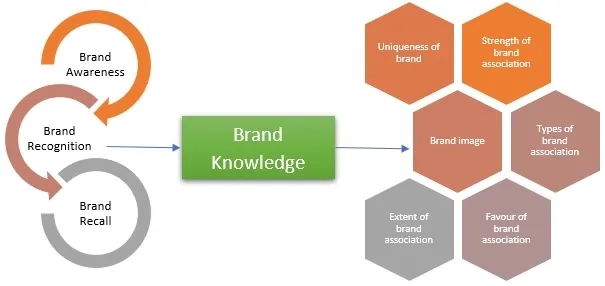
Image Source: MBA Skool
Business Goal: To increase brand awareness
SMART Social Media Goals Examples:
- Achieve 200+ social shares on Facebook per post within 3 months
- Post 3x times a week on Facebook and Instagram starting this month
- Double Instagram followers within three months
- Get 50+ repins/pins on Pinterest within three months
KPIs To Track:
- Shares, repins, comments, and likes
- Number of posts per week
- Follower count (New/lost followers)
- Brand Mentions (or brand hashtag usage)
- Impressions on your posts and stories
- Reach on your posts and stories
How To Monitor Brand Awareness?
Almost all social media networks offer inbuilt analytics to measure impact on a particular platform. However, they come with some limitations and do not allow the measurement of in-depth metrics. Social media management tools such as Statusbrew offer solutions to track the brand awareness indicators and determine your followers' growth and reach across numerous platforms.
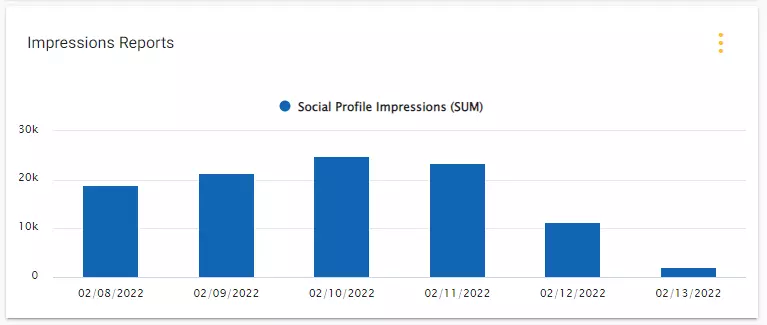
Goal 2: Increase Engagement With Your Community
Building engagement is an essential social media goal as it encourages brand building, generates referrals, determines how your content is prioritized and how many people you will reach through those content. On social media, your audience's engagement is measured by the number of likes, shares, and comments made on your posts. In other words, engagement provides insights into how effective your content is in capturing the interest of your audience.
If your goal is to increase engagement, you should design a marketing strategy to produce content that provides maximum value to your audience. For instance, if you run a real estate agency, you can post or share an article on "10 tips to increase the sale price of your home". This content will provide an informative checklist to help the real estate agency target the correct audience.
Increasing engagement with your current follower base will allow you to enrich customer and follower relationships, start conversations with your followers and provide excellent customer service to them. It's also an excellent way to solidify your brand voice and build a community on social media.
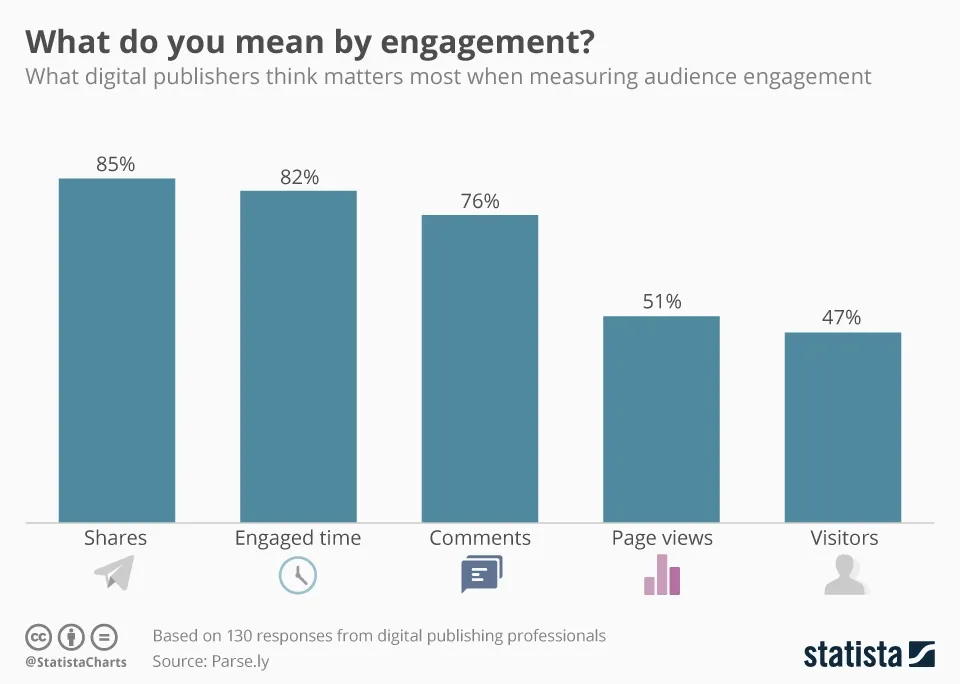
Image Source: Statista
Business Goal: To increase engagement with your community
SMART Social Media Goals Examples:
- Increase social shares across all channels by 25% this year
- Achieve 35+ comments per Facebook post within two months
- Improve social media click-through-rates by 15% this quarter
KPIs To Track:
- Number of shares, likes, and comments
- Brand Mentions (or brand hashtag usage)
- Social media click-through-rates
- Web traffic referred via social media
How To Measure Increase In Engagement?
Just as brand awareness data, you can track social media engagement metrics using the inbuilt analytics tool provided within the social media platforms themselves such as Facebook Analytics, Instagram Insights or Twitter analytics You may utilize a social media analytics tool such as Statusbrew to assist you with in-depth metrics that the inbuilt tools won’t offer.
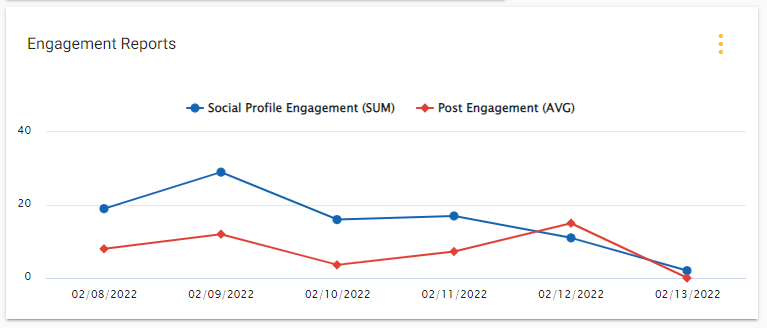
Goal 3: Grow Your Social Media Audience
The number of people using social media worldwide continues to grow every year at a significant rate. More than half of the world's population uses social media now. As social media continues to grow, it's no surprise that marketers turn to it to find new audiences, customers, and potential leads.
Growing your audience base on social media can get your brand in front of more users, which can help you achieve many other social media goals. Posting relevant content and being consistent with your social media efforts can help you achieve this goal. But remember that follower growth takes time, so you need to be patient here!
Business Goal: To grow your social media audience
SMART Social Media Goals Examples:
- Increase the number of post impressions by 35% this quarter
- Improve the brand mentions on Twitter by 15% this quarter
- Achieve 150+ social shares per blog article within six months
KPIs To Track:
- Post/social media ad impressions
- Social shares per blog post/social post
- Brand Mentions (or brand hashtag usage)
- Engagement on your content (likes, shares, comments)
- Follower count
How To Monitor Growth In Social Media Audience?
If you want to know the number of net new followers gained in the last month or if you wish to understand how fast did you gain last month's net new followers, you need to do a little math here.
For a single social media platform, measure your net new followers over the period of a month. Divide your net new followers by your total audience on that particular platform. Multiply the result of division by 100 to get your audience growth rate percentage for the month.
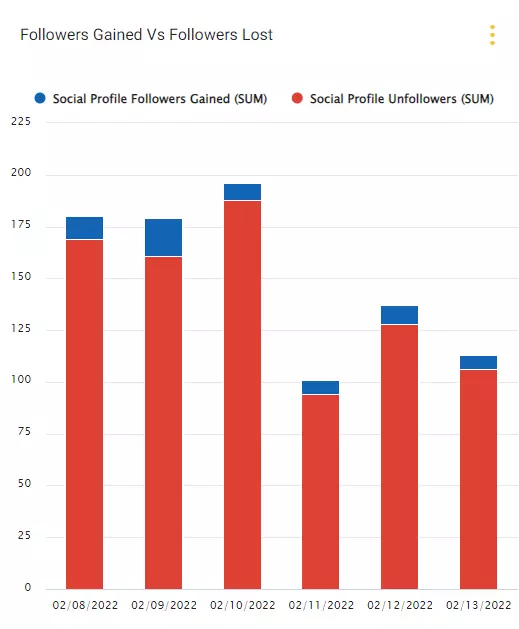
Goal 4: Generate Leads
Social media can be used to inform your followers about your sales and promotions or to share information about your product or service.
In several cases, boosting engagement on social media isn't enough. Many brands choose to make lead generation the primary social media goal for their business. Lead generation is where a brand can reach out to, and entice new customers to enter the sales funnel. If this is your social media goal, all your efforts on social are used to prime them for a sale or conversion.
In order to achieve this goal, you need to run through different customer journeys and nurture marketing campaigns to persuade them to do business with you. With lead generation campaigns, you play the long game and nurture your prospects. The suitable metrics here for assessing your progress can be subscriptions, downloads, clicks, and conversions.
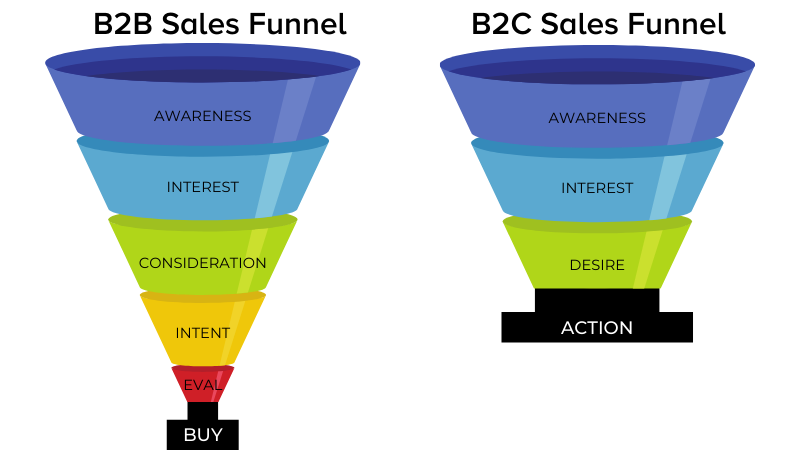
Image Source: VMG Studios
Business Goal: To generate more leads
SMART Social Media Goals Examples:
- Improve click-through-rate on Facebook CTAs by 20% within two months
- Increase traffic referred via social media to landing pages by 12% this year
- Improve conversion rate on Instagram product pages by 5% this quarter
KPIs To Track:
- Click-through-rate on Facebook CTAs
- Page-specific web traffic via social media
- Revenue generation/conversion rate from Instagram product pages
- Number of leads gained from social media
- Email or newsletter sign-ups
- Website traffic
How To Track Social Media Lead Generation?
Google Analytics is quite strong in measuring this goal. If you set some conversion objectives, you can easily track the lead generation from social media with the help of the reports from Google Analytics.
To view reports once you have set up a conversion goal, navigate to Acquisition > Social > Conversions in Google Analytics and choose the conversion goal you want to monitor. The conversion report will show you how many leads your social media channels are generating and which channel is generating the most leads. Other analytics platforms, such as Mixpanel, can also provide you with this information.
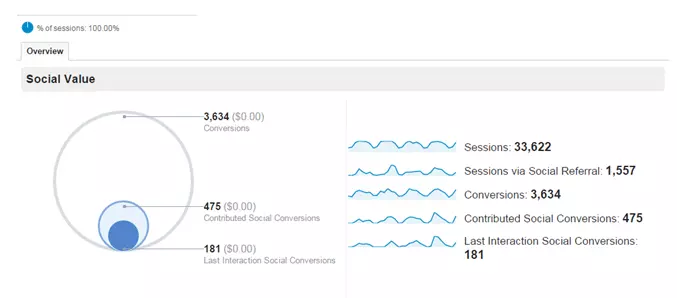
Image Source: Mainstreethost
Goal 5: Increase Traffic To Your Website
When it comes to building an online presence, your website is your H.Q. Driving traffic to your site is another common social media goal for SMEs. The more visitors you get onto your website, the more you expose them to your brand proposition and targeted content such as blogs or newsletters. Driving traffic to your website will also improve your search engine ranking as an added bonus.
If driving website traffic is your social media goal, you need to make your website easy to find. Include call-to-action (CTA's) in every post you make. This will help to boost your click-through rates and drive traffic to your site. To measure this social media goal, you need to use Google Analytics.
Google Analytics will help you to determine from which social media platforms your customers are coming (traffic per social channel), the quality of the customers being sent from those social channels, the quality of content on your website (bounce rates), and which messaging resonates the most with your customers (clicks). Reviewing these metrics will help you determine areas for improvement so you can refine your marketing strategy accordingly.
Social media is an excellent way to lead followers to your website or get sign-ups. Be sure to have your contact information, address, website links, and any other applicable information front and center on your social pages. Optimizing your social pages will help greatly in achieving this goal.
Business Goal: To increase website traffic coming from social media
SMART Social Media Goals Examples:
- Improve social ad click-through-rates by 5% this quarter
- Increase average social media click-through-rate by 10% this year
- Increase social media traffic share to 20% this year
KPIs To Track:
- Social ad click-through-rates
- Organic social click-through-rates
- Website traffic
- Average traffic share by traffic source
- Email or newsletter sign-ups
- Website clicks from your social profile
How To Measure Increase In Website Traffic?
Google Analytics is one of the simplest tools to measure website traffic. It gives you information on your website or blog's traffic from several sources, including social media. To learn about your website traffic from your social media networks, navigate to Acquisition > All Traffic > Channel.
This will display the number of visits from each channel, the proportion of total traffic, the bounce rate, and other information. You can further break down this data to discover which platforms were delivering that traffic by clicking on the "Social" tab.
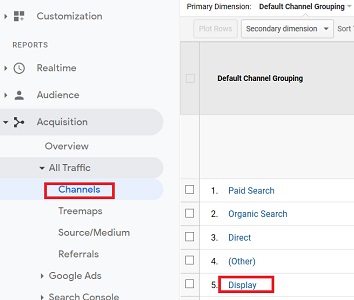
Conclusion
With the social media landscape changing so fast, new goals and metrics for success emerge regularly. Simply being present on social media isn't enough for a brand. The major purpose of building a brand on social media is to engage your target audience and communicate with every potential consumer to build a community.
Setting specific social media goals is necessary if you want to get the most out of your social media approaches. Specific goals of social media enable you to create highly focused content that improves your social performance.
Looking for a social analytics tool to track the performance of your marketing campaign? Try Statusbrew. With several ready-to-use reporting templates and total flexibility to customize these reports, Statusbrew will help you determine whether your social initiatives have led to positive results and where adjustments are needed to strengthen your marketing campaigns - in no time.
Statusbrew is an all in one social media management tool that supports Facebook, Instagram, Twitter, Linkedin, YouTube, and even Google My Business.




Explore the Statusbrew range of social media tools
Cancel anytime!